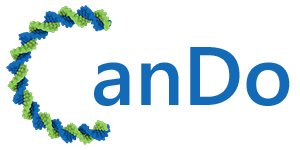The finite element modeling framework CanDo was invented and developed at the Massachusetts Institute of Technology by Prof. Do-Nyun Kim (Seoul National University) while he was a postdoctoral research associate in the lab of Prof. Mark Bathe (MIT). The original implementation of CanDo was limited to modeling honeycomb and square lattice DNA assemblies designed using caDNAno [6] and was published in collaboration with the lab of Prof. Hendrik Dietz (TUM) that performed extensive experimental validation of CanDo’s predictions [9, 10].
Dr. Keyao Pan subsequently built on the work of Prof. Kim by enabling off-lattice modeling using either Tiamat or CanDo file formats while he was a postdoctoral research associate in the lab of Prof. Bathe, which was published in collaboration with the lab of Prof. Hao Yan (ASU) that performed extensive experimental validation of CanDo’s predictions [11]. In his work, Dr. Pan additionally developed the ability to generate atomic structures from CanDo’s finite element modeling predictions, as well as the ability to simulate long time-scale dynamics of DNA assemblies using Brownian Dynamics [14].
CanDo predicts the 3D solution shape and flexibility of programmed DNA assemblies using a mechanical model of DNA that assumes the double-helix to be a homogeneous elastic rod with axial stretching, twisting, and bending stiffnesses that have been measured experimentally [8]. Double-stranded crossover motifs that connect neighboring DNA duplexes are incorporated into CanDo to predict the complex 3D solution shapes shown in [9-10]. Representing the mechanical properties of DNA using the finite element method offers the ability to predict highly complex 3D geometries and their flexibility that cannot be predicted analytically.
Finite element simulations were originally implemented in CanDo using the commercial finite element modeling software ADINA, which was replaced in CanDo’s online server on March 1st, 2018 by the much more broadly available commercial finite element modeling software Abaqus by Dassault Systemes, Inc. Dassault Systemes, Inc. supports the free online use of CanDo’s web-server, and because most Academic Institutions also have academic licenses of Abaqus, CanDo WebServer users also have the ability to import their CanDo model into the Abaqus modeling environment to perform additional mechanical and other analyses locally on their own workstation using the Abaqus input file that is included in CanDo WebServer output.
Flexibility maps of DNA assemblies are represented as thermally-induced fluctuations of the assembly in solution at room temperature, which are computed using the equipartition theorem of statistical mechanics and normal mode analysis [14], as shown for proteins in [15-16]. Atomic models of DNA nanostructures are generated by the online server both for the minimum free energy 3D solution shape and its thermal fluctuations about this shape, as demonstrated in applications of CanDo to the design of light-harvesting antennas [17] and DNA casting molds for inorganic nanoparticles [18].
In order to run CanDo, users must generate an input DNA topology for their programmed DNA assembly using either caDNAno, Tiamat, or CanDo file formats, as described in the Tutorial section of this website. caDNAno files can be input to this webserver for honeycomb and square lattice models. Alternatively, CanDo may be downloaded from the links below (available soon) and run locally on your own computer using either caDNAno, Tiamat, or CanDo file formats as long as you have installed MATLAB, UCSF Chimera, and either the widely available software program Abaqus (for caDNAno file input), or ADINA (for caDNAno, Tiamat, or CanDo file input). Tiamat and CanDo file formats will also be made available for use with Abaqus soon.
The integration of Abaqus into CanDo was performed collaboratively by the Kim and Bathe Labs. CanDo’s online web server is enabled by Dassault Systemes‘ generous license terms that offer free usage of the underlying finite element solver Abaqus by CanDo’s academic users worldwide.
The Bathe Lab is grateful for financial support to its sponsors that enabled the development of CanDo, including the Office of Naval Research, the National Science Foundation, and the Army Research Office. The Kim Lab is grateful for financial support from the National Research of Foundation of Korea (NRF) through the Basic Science Research Program (2016R1C1B2011098) and the Creative Materials Discovery Program (2017M3D1A1039422).
We are grateful to CanDo’s users for citing this primary publication for scientific attribution of CanDo to its inventors and developers:
DN Kim, F Kilchherr, H Dietz, M Bathe. Quantitative prediction of 3D solution shape and flexibility of nucleic acid nanostructures. Nucleic Acids Research, 40(7):2862-2868 (2012). [ Pubmed ]
and secondarily this publication for the original exposition of its predictive capabilities:
CE Castro, F Kilchherr, DN Kim, EL Shiao, T Wauer, P Wortmann, M Bathe, H Dietz. A primer to scaffolded DNA origami. Nature Methods, 8: 221-229 (2011). [ Pubmed ]
Google Groups Forum
Please post your questions related to the use of CanDo to this Google Groups Forum, where commonly asked questions can be answered and discussed.

